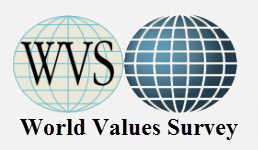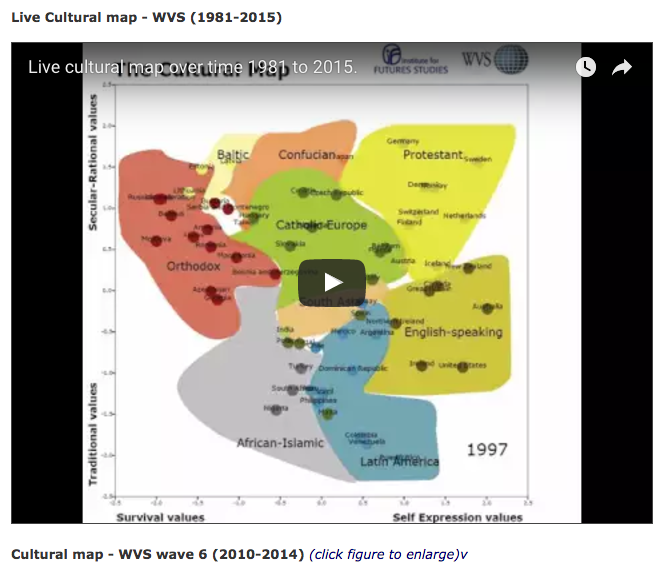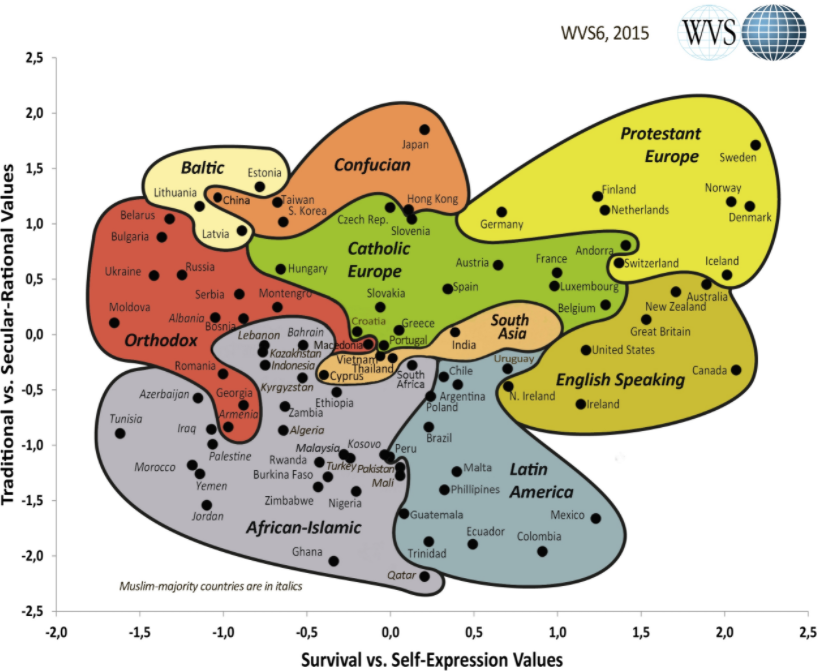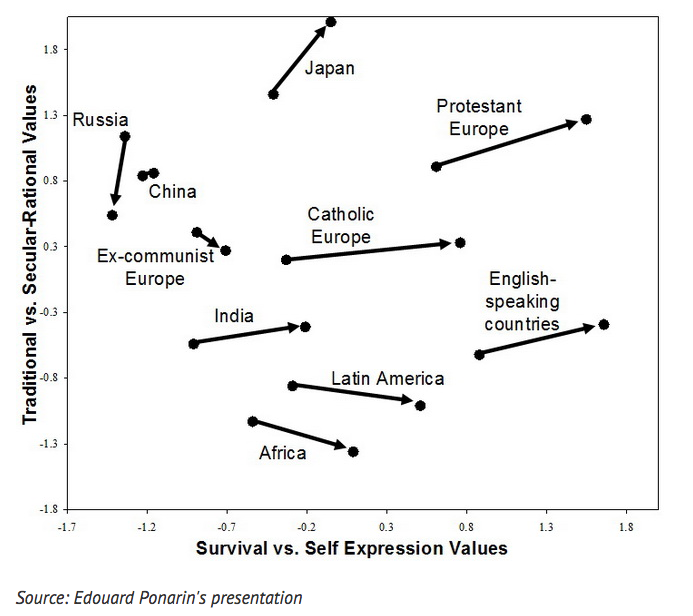
In my last post I mentioned the World Values Survey (WVS). This is a fascinating long-term project conducted in a good number of countries around the globe. The Wikipedia Entry on the WVS is a good brief introduction to the study. The study is a European-based initiative and in 1981 when it started was focused mainly on more developed societies. But once the value of the study became evident it has expanded to include a wide range of countries. One of the most interesting outcomes has been the work political scientists Ronald Inglehart and Christian Welzel have done using the rich survey data.
They suggest that there are two major dimensions of cross-cultural variation in the world:
- Traditional values versus Secular-rational values;
- and Survival values versus Self-expression values.
The WVS home page explains these 4 key terms.
Traditional values emphasise the importance of religion, parent-child ties, deference to authority and traditional family values. People who embrace these values also reject divorce, abortion, euthanasia and suicide. These societies have high levels of national pride and a nationalistic outlook.
Secular-rational values have the opposite preferences to the traditional values. These societies place less emphasis on religion, traditional family values and authority. Divorce, abortion, euthanasia and suicide are seen as relatively acceptable. (Suicide is not necessarily more common.)
Survival values place emphasis on economic and physical security. It is linked with a relatively ethnocentric outlook and low levels of trust and tolerance.
Self-expression values give high priority to environmental protection, growing tolerance of foreigners, gays and lesbians and gender equality, and rising demands for participation in decision-making in economic and political life.

There is a very engaging and valuable resource available at the WVS website called the Inglehart-Welzel Cultural Map. This map can be viewed over time and shows some very interest changes. You can play the time lapse resource labelled the “Live Cultural Map” on the WVS website.
I thoroughly recommend viewing this excellent resource. It makes a real impact!
The 2015 map, which is the most recent, is shown below.

The map shows the location of each country surveyed and identifies nine different cultural “types”. The WVS data is used to plot the “location” if countries on two different scales – the Traditional vs secular-rational values scale on the left axis and the survival vs self-expression values scale on the bottom axis. So this resource shows clearly how values vary through different cultures and societies. This map is a powerful discussion resource.
For example, what does the map tell us about the values differences between Sweden, New Zealand, India and Tunisia?
And what are the contrasts between Protestant Europe, Catholic Europe and the Orthodox countries?
What might be some of the reasons for these large differences?
The WVS data can be used in a whole variety of ways when thinking about values.
The graph below right was produced by Russian scholar Professor Edouard Ponarin of the Department of Political Science and Sociology at the European University in St. Petersburg. He plotted this graph to show that Russian values since the 1990s have moved in a very different direction from most of the rest of the world! He calls the change a “slide into greed and suspicion” while most of the rest of the world has become more positive in their values and beliefs.
University in St. Petersburg. He plotted this graph to show that Russian values since the 1990s have moved in a very different direction from most of the rest of the world! He calls the change a “slide into greed and suspicion” while most of the rest of the world has become more positive in their values and beliefs.
The interested observer will note some other contrasts on this graph. Japan has moved strong toward secular-rational values and moderately toward self-expression values over the 1995 – 2015 period. Europe and English speaking countries have moved strongly toward more self-expression values and moderately toward more secular-rational values.
What other interesting changes can you or you students see on this chart?
Another very interesting
 use of WVS data …
use of WVS data …
… has been made by Inglehart and Welzel on page 112 of their book Modernization, Cultural Change, and Democracy: The Human Development Sequence first published in 2005.
This chart focuses on the different values positions of the generations in selected countries in 2005. You can see that in some countries like India and Nigeria the differences between generations are quite small. On the other hand in countries like Germany and Spain, there are large variations in values between older and younger people.
What would you or your students suggest explains these marked contrasts between countries?
If you or students wanted to do some analysis of the New Zealand Data from this study you can go to:
http://www.worldvaluessurvey.org/WVSDocumentationWV6.jsp
…and type New Zealand into the box at the top right.
So what are some of the over all findings from this study?
The Wikipedia page and the WVS findings and insights page list 30 main findings. Here a few examples.
- People’s priorities shift from traditional to secular-rational values as their sense of security increases (or backwards from secular-rational values to traditional values as their sense of security decreases)
- People’s priorities shift from survival to self-expression values as their sense of individual agency increases (or backwards from self-expression values to survival as the sense of individual agency decreases)
- The strongest emphasis on traditional values and survival values is found in the Islamic societies of the Middle East. By contrast, the strongest emphasis on secular-rational values and self-expression values is found in the Protestant societies of Northern Europe
- A specific subset of self-expression values—emancipative values—combines an emphasis on freedom of choice and equality of opportunities. Emancipative values, thus, involve priorities for lifestyle liberty, gender equality, personal autonomy and the voice of the people
- If set in motion, human empowerment advances on three levels. On the socio-economic level, human empowerment advances as growing action resources increase people’s capabilities to exercise freedoms. On the socio-cultural level, human empowerment advances as rising emancipative values increase people’s aspirations to exercise freedoms. On the legal-institutional level, human empowerment advances as widened democratic rights increase people’s entitlements to exercise freedoms
- As long as physical survival remains uncertain, the desire for physical and economic security tends to take higher priority than democracy. When basic physiological and safety needs are fulfilled there is a growing emphasis on self-expression values.
- The spread of self-expression values leads to the emergence of democratic institutions, that enable people to gain growing freedom of choice in how to live their own lives
- While economically advanced societies have been changing rather rapidly, countries that remained economically stagnant showed little value change. As a result, there has been a growing divergence between the prevailing values in low-income countries and high-income countries.
- Although a majority of the world’s population still believes that men make better political leaders than women, this view is fading in advanced industrialised societies, and also among young people in less prosperous countries.
- The WVS has shown that from 1981 to 2007 happiness rose in 45 of the 52 countries for which long-term data are available. Since 1981, economic development, democratisation, and rising social tolerance have increased the extent to which people perceive that they have free choice, which in turn has led to higher levels of happiness around the world.
This study is a values learning goldmine! Throughly recommended!
